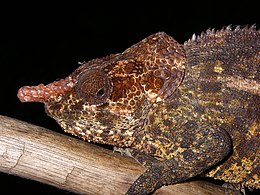Calumma crypticum
| Calumma crypticum | |
|---|---|

| |
| Male | |

| |
| Female | |
| Scientific classification | |
| Domain: | Eukaryota |
| Kingdom: | Animalia |
| Phylum: | Chordata |
| Class: | Reptilia |
| Order: | Squamata |
| Suborder: | Iguania |
| Family: | Chamaeleonidae |
| Genus: | Calumma |
| Species: | C. crypticum
|
| Binomial name | |
| Calumma crypticum Raxworthy & Nussbaum, 2006
| |

| |
Calumma crypticum, commonly known as the cryptic chameleon or blue-legged chameleon, is a species of chameleon found in eastern Madagascar.[2][1][3][4]
Taxonomy
This species was first described in 2006 as Calumma crypticum by Raxworthy & Nussbaum, one of six new species from mountain regions of Madagascar.[5] It is very similar to, and was previously included in, the short-horned chameleon (Calumma brevicorne), but in 2007, Boumans et al. confirmed that it was sufficiently genetically distinct to be considered a valid species.[1]
Description
Calumma crypticum grows to a length of about 12 cm (5 in) and has large flap-like lobes at the back of the head. The species is sexually dimorphic, the male having a longer snout with a horn-like protrusion on its upper surface, which the female lacks. As with other chameleon species, the colour is variable, depending on the colour of the surroundings, the ambient temperature, and variations in the level of light, but this species is usually quite colourful with rich browns, blues and greens, and the legs are often marked with blue.[6]
Distribution and habitat
Calumma crypticum is endemic to eastern Madagascar where it is a mid-altitude species occurring between 1,050 and 1,850 m (3,445 and 6,070 ft) above sea level. Its range extends from the Tsaratanana Massif and the Ivakoany Massif. It is an arboreal species, living in humid forests; its distribution is patchy because of forest clearance on the central highlands between the mountain blocks, but there is a subpopulation around Ambohitantely in the central west of the island.[1]
Status
This chameleon has a widespread distribution and occurs in a number of protected areas. Suitable habitat is being cleared for agriculture and the population is gradually declining, however the species is sufficiently common that the International Union for Conservation of Nature has assessed its conservation status as being of least concern.[1]
-
Male, Ranomafana
-
Female, Ranomafana
References
- ^ a b c d e Jenkins, R.K.B.; Andreone, F.; Andriamazava, A.; Anjeriniaina, M.; Brady, L.; Glaw, F.; Griffiths, R.A.; Rabibisoa, N.; Rakotomalala, D.; Randrianantoandro, J.C.; Randrianiriana, J.; Randrianizahana, H.; Ratsoavina, F.; Robsomanitrandrasana, E. (2011). "Calumma crypticum". IUCN Red List of Threatened Species. 2011: e.T172886A6935865. doi:10.2305/IUCN.UK.2011-2.RLTS.T172886A6935865.en. Retrieved 20 November 2021.
- ^ Glaw, Frank; Vences, Miguel (2007). A Field Guide to the Amphibians and Reptiles of Madagascar (3rd ed.). Cologne, Germany: Vences & Glaw Verlags. ISBN 978-3929449037.
- ^ Uetz, Peter; Hallermann, Jakob (2022). "Calumma crypticum RAXWORTHY & NUSSBAUM, 2006". Reptile Database. Hamburg: Zoological Museum Hamburg. Retrieved 5 June 2022.
- ^ "Calumma crypticum". www.ncbi.nlm.nih.gov. Retrieved 19 August 2013.
- ^ Raxworthy, Christopher J.; Nussbaum, Ronald A. (2006). "Six new species of occipital-lobed Calumma a new description and revision of Calumma brevicorne". Copeia. 2006 (4): 711–734. doi:10.1643/0045-8511(2006)6[711:SNSOOC]2.0.CO;2. S2CID 86209876.
- ^ Behrens, Ken; Barnes, Keith (2016). Wildlife of Madagascar. Princeton University Press. pp. 196–198. ISBN 978-1-4008-8067-6.
External links
 Media related to Calumma crypticum at Wikimedia Commons
Media related to Calumma crypticum at Wikimedia Commons
- Articles with short description
- Short description is different from Wikidata
- IUCN Red List least concern species
- Articles with 'species' microformats
- Commons category link from Wikidata
- Calumma
- Endemic fauna of Madagascar
- Reptiles described in 2006
- Reptiles of Madagascar
- Taxa named by Ronald Archie Nussbaum
- Taxa named by Christopher John Raxworthy
- Fauna of the Madagascar subhumid forests


